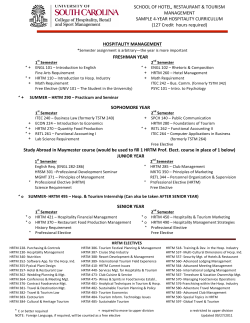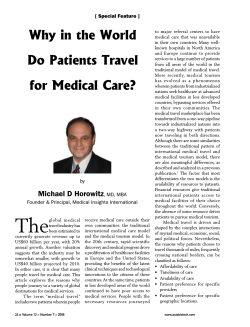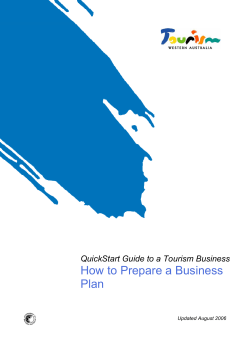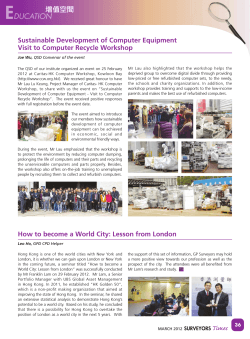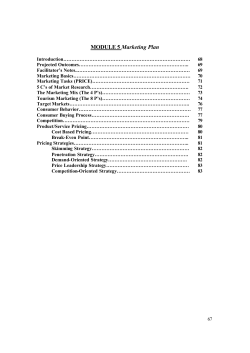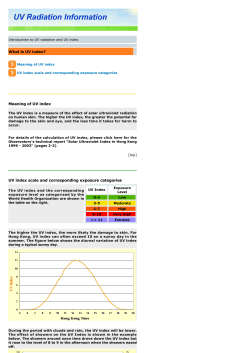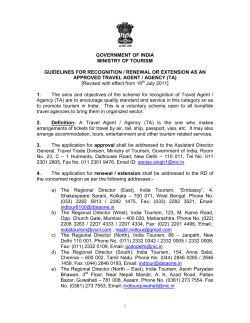
SAMPLE 2 FORM RDC/1A THE HONG KONG POLYTECHNIC UNIVERSITY RESEARCH DEGREE PROPOSAL
SAMPLE 2 FORM RDC/1A (Revised Oct 2006) THE HONG KONG POLYTECHNIC UNIVERSITY RESEARCH DEGREE PROPOSAL Doris Wu Note: Please note that the information given in this form will only be used for processing this application. Layout and length A typical PhD proposal will be somewhere between three and four thousand words (excluding references and appendices). While we do not insist on a definite layout, applicants are encouraged to keep the following in mind: i.e. about 13 pages with 1.5 spacing and leaving enough margin for comments. 1. Project Title: Econometric Analysis of Tourist Expenditures in Hong Kong 2. Project Objectives: (Purpose of proposed investigation) The theory of consumer demand has been a central topic in Economics for many years (Edgerton et al., 1996). Much effort has been exerted in bridging the gap between the pure theory of consumer behaviour and its empirical implementations. The formalised theory of consumer demand has stimulated the developments and applications of econometric methodologies. Not only has the rapid expansion of international tourism led to increasing contribution to national and global economies, it has also motivated growing interests in tourism demand analysis among academics and business practitioners. Tourism demand studies are of particularly importance for the countries/regions where tourism plays a key role, such as Hong Kong. However, those latest developments in econometric methodologies have been rarely applied to the tourism context. The limitations of the traditional methodologies employed in previous tourism demand analyses may have biased the empirical results, and more seriously, led to misleading policies. This study, therefore, aims to overcome this problem by introducing a theoretically sound and technically effective framework in tourism demand analysis. © No part of this proposal could be reproduced in any form without the permission of the author. 1 The empirical analysis of this study will be based on the data related to the inbound tourism in Hong Kong. Tourism has become the second largest foreign currency earner in Hong Kong since 1995 and the income generated from tourism has contributed around 6% to Hong Kong’s gross domestic products (GDP) over the last decade (Zhang et al., 2001). The service sector in Hong Kong, particularly, retailing, accommodation, catering, arts and entertainment businesses, has either directly or indirectly benefited from international tourism in Hong Kong (Heimstra and Wong 2003). Although the tourism industry has played an ever-increasing role in the generation of wealth and employment in Hong Kong, it also faces critical challenges of creating and maintaining a sustainable competitive advantage in such an environment that other Asian destinations particularly Singapore, Taiwan, Thailand and Mainland China are gaining a growing popularity. In order to adopt effective tourism policies and strategies in respond to this challenge, the public agencies and tourism businesses in Hong Kong need to have accurate knowledge about the characteristics of its key source markets, such as their spending and seasonal patterns, and about the determinants of these patterns. The main objectives of this study are as follows: i. To model tourists’ expenditure allocation to different categories of goods and services including shopping, hotel bills, meals outside hotels, entertainment, tours and others, using a series of LAIDS approach. ii. To quantify the effects of budget (income) and price changes on tourists’ expenditures of each source market by computing expenditure and own-price elasticities, based on the estimated TVP-EC-LAIDS models. The source markets include Mainland China, Taiwan, Japan, USA, Singapore, UK, South Korea and Australia. iii. To identify interrelationships between different categories of goods/services, in terms of substitutability and complementarity, in each of the eight demand system models. iv. To examine the effects of seasonality on tourists’ expenditures by source market. v. To compare the impacts of income, price and seasonality on tourism demand between different origin countries/regions. vi. To recommend appropriate tourism suggestions, which will be useful to tourism industry stakeholders and government. © No part of this proposal could be reproduced in any form without the permission of the author. 2 3. Scope and Background of Research: (Please identify key issues/problems to be addressed) Decision-makers in tourist destinations, especially those destinations where tourism is one of the major sources of foreign exchange, have put much effort in trying to understand the key determinants of demand for their tourism products and services in order to formulate and implement the most effective tourism policies and strategies. Many econometric studies on tourism demand have been published over the last three decades and they have undoubtedly made significant contributions to the tourism demand literature (Witt and Witt, 1995). Most of those studies, however, are based on the single-equation approach, which suffers from specific limitations. Eadington and Redman (1991) noted that this approach is incapable of analyzing the interdependence of budget allocations to different consumer goods/services. For example, a decrease in hotel room rate may stimulate tourists’ spending on shopping and entertainment. However, lacking an explicit basis in consumer demand theory, the single-equation approach cannot adequately capture the influence of price changes in one tourism good/service (or in a particular destination) on the demand for other products/services (or destinations). Therefore, the demand elasticities, specifically the cross-price elasticity, derived from the single equation approach do not reflect the true substitute effects, which may result in unreliable policy recommendations. Another limitation of the single-equation approach is that it cannot be used to test for symmetry and adding-up hypotheses suggested by demand theory. The system of equations approach can overcome these limitations. By including a group of equations (one for each consumer good) in the system and estimating them simultaneously allows one to examine how consumers choose bundles of goods in order to maximize their preference or utility given budget constraints. Although there are a number of system modelling approaches available, the almost ideal demand system (AIDS), introduced by Deaton and Muellbauer (1980), has been the most commonly used method for analyzing consumers’ spending behaviour, as it has considerable advantages over the others. © No part of this proposal could be reproduced in any form without the permission of the author. 3 Although the AIDS model has received considerable attention in the economic literature in terms of analyzing households’ demand for nondurable goods (particularly food categories), the application of this approach to tourism demand studies is still rare. A thorough literature search has identified the following publications. O’Hagan and Harrison (1984), White (1985), Syriopoulos and Sinclair (1993), Papatheodorou (1999), Papanikos and Sakellariou (1997), De Mello et al. (2002) and Divisekera (2003) employed the static AIDS in its linearly approximated form (LAIDS) to examine tourist expenditures in a group of destinations by a particular origin country. Lyssiotou (2001) specified a non-linear AIDS model to study the spending behaviour of the UK the outbound tourists. Unlike all the other studies mentioned above, Durbarry and Sinclair (2003) estimated an error correction LAIDS (EC-LAIDS) to analyze the demand for tourism to Italy, Spain and UK by French residents. However, the error correction AIDS models in their study took a reduced form as all the short-run explanatory variables were omitted due to their statistical insignificance. Instead of focusing on tourists’ expenditure allocation to different destinations, Fujii et al. (1985) investigated tourists’ expenditure on different consumer goods in one particular destination. Six broad categories of goods consumed by tourists were investigated in their study. They are (1) food and drink; (2) lodging; (3) clothing, accessories and jewellery; (4) local transport; (5) recreation and entertainment and (6) other. As the authors argued, such an analysis is particularly important in assessing the effects of public policies on the pricing of goods/services at the tourist destinations. Moreover, the analysis of the interrelationships between the demands for different categories of goods/services will shed new light on identifying the comparative advantages of the various sectors, such as retailing and lodging within the tourism industry. The AIDS model adopted by Fujii et al. (1985) was static in its model specification, which does not reflect the dynamic nature of tourists’ decision making and the reliability of the empirical findings is questionable. Hitherto, there is no known published research focusing on tourists’ expenditure allocation to different product categories. The improvements of the AIDS specification, in terms of the inclusion of error correction mechanism to capture the dynamics of consumers’ decision making, have not benefited the tourism studies in real sense. To bridge this gap, this project will introduce a time varying parameter error correction model representation of the LAIDS (TVP-EC-LAIDS) to investigate the expenditure patterns of tourists using the data related to Hong Kong inbound tourism. © No part of this proposal could be reproduced in any form without the permission of the author. 4 It is anticipated that this research will further advance the tourism demand analysis techniques and shed more light in the understanding of tourists’ consumption behaviour not only in Hong Kong, but also in other parts of the world. Based on the TVP-EC-LAIDS framework, eight leading contributors to Hong Kong tourism receipts will be included in the investigation. These contributors include Mainland China, Taiwan, Japan, USA, Singapore, UK, South Korea and Australia. The spending of tourists from these eight origin countries/regions accounted for about 81% of the total tourist expenditures in Hong Kong (Hong Kong Tourism Board, HKTB, 2001). A preliminary research has found that tourists from these origins have different spending patterns. For example, the 2003 figures show that American tourists spent 43.2% and 31.3% of their total budget on hotel bills and shopping, respectively. On the other hand, tourists from Mainland China spent 68.5% on shopping and only 12.3% on hotel bills. Demand from different source markets also displays different seasonal patterns. For instance, the most popular season to visit for Chinese tourists is December, while UK visitors peaked in March. Clearly, the spending differentials of tourists from different countries/regions will have important influences on tourism product provision in the different sectors of the economy. This will be systematically analyzed in the study using the proposed modelling methodology. Consistent with the main data source - Statistical Review of Hong Kong Tourism (Hong Kong Tourism Board, 2003), this study will examine tourists’ consumption behaviour divided into six spending categories. They are (1) shopping; (2) hotel bills; (3) meals outside hotels; (4) entertainment; (5) tours and (6) others. These six categories form a complete demand system, and the TVP-EC-LAIDS will be estimated for each of the origin countries/regions. The expenditure and own-price elasticities will be calculated for each system in order to examine the effects of price and budget changes on the demand for each category of products. In addition, the cross-price elasticities will also be estimated and this will allow the identification of the interrelationships between the demands for different goods/services by tourists. Seasonality is also readily accommodated in the TVP-EC-LAIDS, and its effects on tourist expenditure will be examined in the study. © No part of this proposal could be reproduced in any form without the permission of the author. 5 This study is the first attempt to introduce the TVP-EC-LAIDS to the tourism expenditure research. Given its advantages over other LAIDS approach, the TVPEC-LAIDS will produce robust demand estimates and provide reliable information for tourism practitioners. The research findings are expected to provide useful information for policy makers in both the public and private sectors. For example, if different consumption patterns are identified, a diversified marketing strategy for different market segments would be appropriate; if different price elasticities are observed, a flexible pricing policy for different products should be adopted. The identification of a complementary effect between two different products suggests that a joint marketing campaign by the two parties would be necessary. 4. Research Methodology: The AIDS model stems from the neoclassical theory of consumer demand. It has been the most commonly used method for analyzing consumer behaviour as it has considerable advantages over the others. For example, it gives an arbitrary first-order approximation to any demand system; it has a flexible functional form and does not impose any a priori restrictions on elasticities; it is easy to estimate and largely avoids the need for non-linear estimation; the restrictions of homogeneity and symmetry can be tested through linear restrictions on the parameters in the model; it is derived from the consumer cost function corresponding to price-independent generalized logarithmic (PIGLOG) consumer preferences, which permits an exact aggregation over consumers without imposing identical preferences. As far as aggregate data are concerned, a rational representative consumer is assumed to make the budgeting allocation. Therefore, although the AIDS model is developed on the basis of microeconomic theory, it can readily be generalized to the aggregate level (Edgerton et al. 1996). © No part of this proposal could be reproduced in any form without the permission of the author. 6 4.1 Static LAIDS The static AIDS can be viewed as an extension of the Working-Leser model, in which the budget share for good i is related to the logarithms of prices and total real expenditure in the following manner: wi = ai + ∑ γ ij log p j + bi log( x / P ) + vi (1) j where wi is the budget share of the ith good, pj is the price of the jth good, x is total expenditure on all goods in the system, P is the aggregate price index, x/P is real total expenditure, and ai , bi and γ ij are the parameters that need to be estimated. vi is the normal disturbance term. The aggregate price index P in Equation (1) is defined as: log P = a0 + ∑ α i log pi + i 1 ∑∑ γ ij log pi log p j + vi 2 i j (2) where a0 and α i are the parameters to be estimated. It shows that the relationship between the price index P and the prices of individual goods is non-linear, which results in a complicated non-linear estimation of the system. To linearise the relationship, Deaton and Muellbauer (1980) suggested to replace the price index P with Stone’s price index (P*) which takes the form log P* = ∑ w log p i i . The linear i approximation of the AIDS model using this Stone’s price index is termed the LAIDS, and is commonly used in most demand studies. To comply with the theoretical properties of demand theory, i.e. the budget constraint and utility maximisation, the following restrictions are imposed on the parameters in the AIDS model: Adding-up restrictions: ∑a i i = 1, ∑γ i ij = 1 , and ∑b i = 0 which allows for all budget i shares to sum to unity. Due to these restrictions, the residuals variance-covariance matrix Ω is singular. The usual solution is to delete an equation from the system and estimate the remaining equations, and then calculate the parameters in the deleted equation in accordance with the adding-up restrictions. Homogeneity: ∑γ ij = 0 , which is based on the assumption that a proportional j change in all prices and expenditure does not affect the quantities purchased. In other words, the consumer does not exhibit money illusion. Symmetry: γ ij = γ ji , which takes consistency of consumers’ choices into account. © No part of this proposal could be reproduced in any form without the permission of the author. 7 Negativity: this requires the matrix of substitution effects to be negative semidefinite. One subset of the negativity restriction implies that all the compensated own-price elasticities must be negative. Due to the flexible functional form of the LAIDS model, the elasticity analysis can be easily carried out. The demand elasticities are calculated as functions of the estimated parameters, and they have standard implications. The expenditure elasticity ( ε ix ), which measures the sensitivity of demand in response to changes in expenditure, is calculated using ε ix = 1 + bi / wi . The uncompensated own-price elasticity ( ε ii ) and cross-price elasticity ( ε ij ) measure how a change in the price of one product affects the demand for this product and other products with the total expenditure and other prices held constant. They are given by ε ii = λii / wi − bi − 1 and ε ij = λij / wi − bi w j / wi , respectively. In the same way, the compensated price elasticities ( ε ii* and ε ij* ), which measure the price effects on the demand assuming the real expenditure ( x / P ) is constant, are calculated as ε ii* = γ ii / wi + wi − 1 and ε ij* = γ ij / wi + w j . In particular, the sign of the calculated ε ij* indicates the substitutability or complementarity between the destinations under consideration (Edgerton et al., 1996). In the static LAIDS, it is implicitly assumed that there is no difference between consumers’ short-run and long-run behaviour, i.e. the consumers’ behaviour is always in “equilibrium”. However, in reality, habit persistence, adjustment costs, imperfect information, incorrect expectations and misinterpreted real price changes often prevent consumers from adjusting their expenditure instantly to price and income changes (Anderson and Blundell, 1983). Therefore, until full adjustment takes place consumers are “out of equilibrium”. This is one of the reasons why most static LAIDS models cannot satisfy the theoretical restrictions (Duffy, 2002). It is therefore necessary to augment the long-run equilibrium relationship with a short-run adjustment mechanism. Moreover, the static LAIDS pays no attention to the statistical properties of the data and the dynamic specification arising from time series analysis. It is well known that most economic data are non-stationary, and the presence of unit roots may invalidate the asymptotic distribution of the estimators. Therefore traditional statistics such as t, F and R2 are unreliable, and least squares estimation of the static LAIDS tends to be spurious (Chambers, 1993). 4.2 Two stage EC-LAIDS © No part of this proposal could be reproduced in any form without the permission of the author. 8 The concepts of cointegration (CI) and the error correction model (ECM) were first proposed by Engle and Granger (1987), and have been widely used by researchers and practitioners in modelling and forecasting macroeconomic activities over the last decade. Engle and Granger (1987) show that the long-run equilibrium relationship can be conveniently examined using the CI technique, and the ECM describes the short-run dynamic characteristics of the economic activities. If the variables in the regression are cointegrated, the spurious regression problem will not occur. Before examining the CI relationship, all variables concerned need to be tested for unit roots (or orders of integration). If seasonal data are used, seasonal unit roots should be tested. The Augmented Dickey-Fuller (ADF) statistic and the HEGY procedure (Hylleberg et al., 1990) can be used for these tests. Once the orders of integration of the variables have been identified, either the Engle and Granger (1987) two-stage approach or the Johansen (1988) maximum likelihood approach can be used to test for the CI relationship among the variables in the models (Song and Witt, 2000). Once the CI relationship between the dependent variables and the linear combination of independent variables in the long-run LAIDS is confirmed, an ECM presentation of the LAIDS can be achieved and econometrically estimated by appropriate algorithms. In this study two stages EC-LAIDS (see Chambers and Nowman, 1997; Duffy, 2002) will be employed to examine the short-run dynamics equilibrium and it is given by A( L)Δwi = B( L)Δzt + φ ( L)Δdumt + Γ( wt −1 − Πzt −1 − ϕdumt −1 ) + vt where A( L) = I + ∑li =1 Ai Li , B( L) = ∑im= 0 Bi Li and (3) φ ( L) = ∑ is=0 φi Li polynomials in the lag operator L. zt is a intercept vector. are matrix Π , ϕ and Γ are parameter matrices, respectively. l, m and s can be determined by using order selection techniques. Applications of the two stages EC-LAIDS can be seen in the studies of demand for non-durable goods and food products, such as Attfield (1997), Skjerpen and Swensen (2000), and Fanelli and Mazzocchi (2002). Durbarry and Sinclair (2003) and Li., et al. (2004) also introduced this method to tourism demand analysis. © No part of this proposal could be reproduced in any form without the permission of the author. 9 4.3 TVP-LAIDS The specification of the above fixed-parameter EC-LAIDS model implies the speed of short-run adjustment is constant over time. However, in practice this assumption seems to be too strict. Therefore, it is more easily understandable to specify models with time varying parameter (TVP) form to analyse the long-run equilibrium and short-run dynamics of economics phenomenon. TVP technique relaxes the fixed parameter restriction and its long-run form has been successfully applied to economic studies. Recently TVP-EC model receives more attention. However, up to now there are rarely attempt to combine TVP WITH LAIDS model. The exceptions include that Leybourne (1993a, b) who estimate a TVP version of AIDS on an equation-by-equation version. Mazzocchi (2003) explores the TVP ALDS model with full implementation of the time varying homogeneity and symmetry constraints. Li et al. (2006) specifically advanced the forms of TVP long-run LAIDS (TVP-LR-LAIDS) and TVP-EC-LAIDS and originally applied them in the context of tourism forecasting study. At the same time, Mazzocchi (2006) also employed EM (expectation and maximisation) algorithm for the construction of long-run and short-run TVP AIDS model in the study of UK demand for alcohol and tobacco. 4.3.1 TVP-LR-LAIDS The Equation (1) can be represented as a time varying parameter form and each equation of the system can be written in the following one-dimension state space form: wit = zt′π it + ϑi dumt + uit (4) uit ~ N (0, H t ), t = 1,..., T (5) π it + 1 = π it + ξit (6) π 1 ~ N (c1 , P1 ), ξit ~ N (0, Qt ) (7) where wit and uit are the ith elements of wt and ut respectively; z′ is the transpose of matrix z. ϑi is a q-vector of disturbance terms, π it is an unobserved state vector following a multivariate random walk. H t and Qt are initially assumed to be known. © No part of this proposal could be reproduced in any form without the permission of the author. 10 Correspondingly, the whole system can be written as: wit = zt∗πΠ ∗t + ϑdumt + uit (8) Π ∗t + 1 = Π ∗t + ξt∗ (9) where zt∗ = I n ⊗ zt′ Π ∗t = (π 1t ,π 2 t ,...,π nt )′ ξt∗ = (ξ1t , ξ 2 t ,..., ξ nt )′ . Combine with the restrictions that M = GΠ ∗t where G is the coefficient matrix of the restriction, the equation (8) can be rewritten as follow: Wt = zt∗Π ∗t + Dt + U t (10) where Wt = ( wt M )′; Z t∗ = ( zt∗ G )′; Dt = (ϑdumt ); U t= (ut 0 )′ . This TVP-LR-LAIDS model broke the limitations generated from fixed-parameter modelling. Therefore it seems easier to reflect the real economics phenomenon. However, its assumption that consumers’ behaviour is always “in equilibrium” is not much realistic because many factors such as habit persistence and imperfect information always cause consumers not to be an equilibrium place until full adjustments take place. As a result, there is the feasibility to construct TVP short-run dynamics model, specifically TVP-EC-LAIDS model in this study, within the long-run equilibrium framework. 4.3.2 TVP-EC-LAIDS In the estimation of the TVP-LR-LAIDS and TVP-EC-LAIDS models, the Kalman filter algorithm (Kalman, 1960) is employed. Each equation of the unrestricted TVP-EC-LARDS can be described as: Δwit = ( ztΔ )'π itΔ + θ i dumt + u Δit (11) πΔ =πΔ +ξΔ (12) it +1 it it where ztΔ = (Δzt , wt −1 − Πzt −1 )' ; π itΔ is the corresponding parameter vector; θ i is the ith row of θ ; u Δit is the ith item of u Δt , the disturbance vector of the measurement equation; and ξ itΔ is the disturbance vector of the state equation. © No part of this proposal could be reproduced in any form without the permission of the author. 11 The state space from of the whole unrestricted TVP-EC-LAIDS is specified as follows: Δwt = ( ztΔ ∗ )'π Δit + θ i dumt + u Δit (13) Π tΔ+ 1 = Π tΔ + ξt∗Δ (14) where ztΔ ∗ = I q + 1 ⊗ ( ztΔ )′; Π tΔ = (π 1Δt , π 2Δt ,..., π ntΔ )' ; ξ tΔ ∗ = (ξ 1tΔ , ξ 2tΔ ,..., ξ ntΔ )′ Different from the fixed-parameter models, the TVP-EC-LAIDS model recursively refines the parameters through Kalman filter algorithm and allows parameters in econometric models to vary over time. As a result, in TVP-EC-LAIDS model the dynamics of changing economic regimes can be readily accommodated and it is likely to generate more accurate forecasts. However, in Li et al. (2006) only unrestricted TVP-LR-LAIDS and TVP-EC-LAIDS equation by equation are estimated using Kalman filter algorithm due to the insufficient observations. This study will extend the empirical field by estimating the whole system using homogeneity-andsymmetry-restricted TVP-EC-LAIDS model in the context of tourism expenditure. At the same time, fixed-parameter static LAIDS and two stages EC-LAIDS models will also be employed for the comparison of estimating accuracy. 4.4 Data Description In this study, quarterly data will be collected from official sources. The number of observations is subject to data availability, and a period of 20 years (80 quarters) is expected to be covered in this study. Eight leading tourist spenders (Mainland China, Taiwan, Japan, USA, Singapore, UK, South Korea and Australia) will be examined. The data of their spending on shopping, hotel bills, meals outside hotels, entertainment tours and other items will be collected from the Hong Kong tourism Board publications. With regard to the price variables, the aggregation of detailed categories of tourist expenditures is necessary to form the price indices for the six broader classes. For aggregating the component price indices, Tornqvist (1936) price index will be used. The advantage of this method is that it allows for moving weights. It has been applied by Fujii et al. (1985). The raw data of individual prices will be collected from Hong Kong Census and Statistics Department. © No part of this proposal could be reproduced in any form without the permission of the author. 12 4.5 Research Plan This project is planned for completion in two and half years. Specifically, the tasks for this period are divided into five sub-periods: 1 ○ 2 ○ Six Months Six Months 4 ○ Eight Months 3 ○ 5 ○ Four Months Ten Months ①. Literature review ②. Data collection and preliminary data analysis ③. Construction of the models ④. Model estimation and analysis of the results ⑤. Summarize and write up research finding © No part of this proposal could be reproduced in any form without the permission of the author. 13 5. Project Significance and Value: Econometric analysis of tourism demand has been overwhelmingly dominated by the single-equation approach. This approach, however, suffers from various theoretical and technical problems which often lead to results which are less than accurate and imperceptibly defensible. This study aims to overcome some of the basic limitations of single equation models by employing a dynamics-enhanced version of the Almost Ideal Demand System (AIDS) model, more specifically known as the time varying parameter error correction linear almost ideal demand system (TVP-EC-LAIDS) to investigate the effects of various influencing factors on tourist expenditure in Hong Kong. This theoretically superior alternative approach, developed by Li, et al. (2006), has rarely been applied to the empirical studies with the only one exception (Mazzocchi, 2006) and has never been used to the tourism expenditure study. This study will be the first attempt to fill in the gap in the tourism literature. This study attempts to apply this technique into the context of tourist expenditure allocation amongst different product categories. Particular focus will be specified with regard to the key source markets’ expenditure allocation to different categories of goods/services such as shopping, hotel bills, meals outside hotels, entertainments and tours. This study aims to quantify the effects of price and budget changes on tourists’ expenditures of each source market and identify the interrelationships between different categories of goods/services, using TVP demand system models. Comparisons of the impacts of income, price and seasonality effects on tourism demand between different countries of origin will also be studied. The empirical results will provide useful information for key tourism players and public agencies in their formulation as well as evaluation of effectiveness of their tourism policies. © No part of this proposal could be reproduced in any form without the permission of the author. 14 Reference The research proposal should include a reference list containing all the reference cited in the proposal using a consistent and appropriate format such as indicated in the APA style guide. 6. References Anderson, G. and Mizon, G. (1983). Parameter constancy tests: Old and new. Southampton University Discussion Paper, no. 8325. Attfield, C. L. F. (1997). Estimating a cointegrating demand system. European Economic Review, 41, 61-73. Blanciforti, L., Green, R., & King, G. (1986). U.S. consumer behavior over the postwar period: An almost ideal demand system analysis. Monograph 40 (Giannini Foundation of Agricultural Economics, University of California). Chambers, M. J. (1993). Consumers’ demand in the long run: Some evidence from UK data. Applied Economics, 25, 727-733. De Mello, M., Pack, A., & Sinclair, M. T. (2002). A system of equations model of UK tourism demand in neighbouring countries. Applied Economics, 34, 509-521. Deaton, A., & Muellbauer, J. (1980). An almost ideal demand system. American Economic Review, 70, 312-326. Divisekera, S. (2003). A model of demand for international tourism. Annals of Tourism Research, 30, 31-49. Duffy, M. (2002). Advertising and food, drink and tobacco consumption in the United Kingdom: A dynamic demand system. Agricultural Economics, 1637, 1-20. Durbarry, R. & Sinclair, M. T. (2003). Market shares analysis: The case of French tourism demand. Annals of Tourism Research, 30, 927-941. Edgerton, D. L., Assarsson, B., Hummelmose, A., Laurila, I. P., Rickertsen, K., & Vale, P. H. (1996). The econometrics of demand systems with applications to food demand in the Nordic countries. London: Kluwer Academic Publishers. Engle, R. F., & Granger , C. W. J. (1987). Cointegration and error correction: Representation, estimation and testing. Econometrica, 55, 251-276. Hiemstra, S., & Wong, K. F. (2002). Factors affecting demand for tourism in Hong Kong. Journal of Travel and Tourism Marketing, 13, 43-62. Hylleberg, S., Engle, R. F., Granger, G. W. J., & Yoo, B. S. (1990). Seasonal integration and cointegration. Journal of Econometrics, 44, 215-238. Johansen, S. (1988). A statistical analysis of cointegration vectors. Journal of Economic Dynamics and Control, 12, 231-254. © No part of this proposal could be reproduced in any form without the permission of the author. 15 Li, G., Song, H., & Witt, S. F. (2004). Modeling tourism demand: A dynamic linear AIDS approach. Journal of Travel Research, 43, 141-150. Li, G., Song, H., & Witt, S. F. (2005). Time varying parameter and fixed parameter linear AIDS: An application to tourism demand forecasting. Journal of Travel Research, 22, 57-71. Lyssiotou, P. (2001). Dynamic Analysis of British Demand for Tourism Abroad. Empirical Economics, 15, 421-436. Mazzocchi, M. (2006). Time patterns in UK demand for alcohol and tobacco: An application of the EM algorithm. Computational Statistics & Data Analysis, 50, 2191-2205. Mazzocchi, M., & Fanelli, L. (2002). A cointegrated VECM demand system for meat in Italy. Applied Economics, 34, 1593-1605. Mazzocchi, M., & Lobb, A. E. (2005). A latent-variable approach to modeling multiple and resurgent meat scares in Italy. The 11th International Conference of the EAAE. Copenaghen, Denmark. O’Hagan, J. W., & M. Harrison, J. (1984). Market shares of US tourism expenditure in Europe: An econometric analysis. Applied Economics, 16, 919-931. Papanikos, G. T., & Sakellariou. C. (1997). An Econometric application of the almost ideal demand system model to Japan’s tourist demand for ASEAN destinations, Journal of Applied Recreation Research, 22, 157-172. Papatheodorou, A. (1999). The demand for international tourism in the Mediterranean region. Applied Economics, 31, 619-630. Phillips, P. C. B. (1991). Optimal inference in cointegrated systems. Econometrica, 59, 283-306. Phillips, P. C. B. (1994). Some exact distribution theory for maximum likelihood estimators of cointegrating coefficients in error correction models. Econometrica, 62, 73-93. Ray, R. (1985). Specification and time series estimation of dynamic Gorman polar form demand systems. European Economic Review, 27, 357-374. Skjerpen, T., & Swensen, A. R. (2000). Testing for long-run homogeneity in the linear almost ideal demand system: An application on Norwegian quarterly data for nondurables. Discussion Paper 289, Statistics Norway. Song, H., & Witt, S. F. (2000). Tourism demand modelling and forecasting: Modern econometric approaches. Pergamon: Oxford. Song, H., Liu, X., & Romilly, P. (1997). A comparative study of modelling the demand for food in the United States and the Netherlands, Journal of Applied Econometrics, 12, 593-611. © No part of this proposal could be reproduced in any form without the permission of the author. 16 Song, H., Romilly, P., & Liu, X. (1999), An empirical study of outbound tourism demand in the UK. Applied Economics, 32, 611-624. Song, H., & Witt, S. F. (2000). Tourism demand modeling and forecasting - Modern econometric approaches. Pergamon: Oxford. Song, H., & Witt, S. F. (2003), General-to-specific modelling to international tourism demand forecasting. Journal of Travel Research, 42, 65-74. Song, H., Witt, S. F., & Jensen, T. C. (2003a). Tourism forecasting: Accuracy of alternative econometric models. International Journal of Forecasting, 19, 123141. Song, H., Witt, S. F., & Li, G. (2003b). Modelling and forecasting demand for Thai tourism. Tourism Economics, 9, 363-387. Song, H., & Wong, K. F. (2003). Tourism demand modeling: A time-varying parameter approach. Journal of Travel Research, 42, 57-64. Song, H., Wong, K. F. & Chon, K. S. (2003c). Modelling and forecasting the demand for Hong Kong tourism. International Journal of Hospitality Management, 22, 435-51. Syripopoulos, T., & Sinclair, T. (1993). A dynamic model of demand for Mediterranean countries. Applied Economics, 25, 1541-1552. Tornqvist, L. (1936). The bank of Finland’s consumption price index. Bank of Finland Monthly Bulletin, 10, 1-8. White, K. (1985). An international travel demand model: US travel to western Europe. Annals of Tourism Research, 12, 529-545. Wong, K. F. (1997a). An investigation of the time-series behaviour of international tourist arrivals, Tourism Economics, 3, 185-199. Wong, K. F. (1997b). The relevance of business cycles in forecasting international tourist arrivals, Tourism Management, 18, 581-586. Zhang, Q. H., Wong, K. F., & Or, Y. S. (2001). An analysis of historical tourism development and its implications to the tourism industry in Hong Kong. Pacific Tourism Review, 5, 15-21. © No part of this proposal could be reproduced in any form without the permission of the author. 17 Other useful information References Cantor, J. (1993). A Guide to Academic Writing. London: Greenwood Press. Huff, A. (1999). Writing for Scholarly Publication. London: Sage Publications. Luey, B. (1990). Handbook for Academic Authors. Cambridge: Cambridge University Press. Rountree, K. & Laing, T. (1996). Writing by Degrees. A Practical Guide to Writing Theses and Research Papers. Auckland: Longman Rudestam, K., & Newton, R. (1992). Surviving Your Dissertation: A Comprehensive Guide to Content and Process. Newbury Park: SAGE Publications. Thomas, L. (1985). Completing Dissertations in the Behavioral Sciences and Education: A Systematic Guide for Graduate Students. San Francisco: Jossey-Bass (Above references were retrieved from the Department of English http://www.engl.polyu.edu.hk/eeprs/Ref_theses%20and%20dissertations.htm#Books_T&D) © No part of this proposal could be reproduced in any form without the permission of the author. 18 7. Details of Any External Collaboration: In these circumstances, are there likely to be any complications associated with the publication of your thesis? Give details. 8. Research Ethics/ Safety Approval (Please read the policy and procedures for safety approval available at the Health, Safety & Environment Office Homepage. Please attach approval letter where appropriate.) I/We confirm that approval: * has been obtained * is not required * will be obtained before the start of the project Human Research Ethics Animal Research Ethics Biological Safety Ionizing Radiation Safety Non-ionizing Radiation Safety Chemical Safety (* Please tick as appropriate) © No part of this proposal could be reproduced in any form without the permission of the author. 19 9. Statement of the Applicant I wish to register for a research degree on the basis of the proposal given in this Form (RDC/1A). I understand that, during the period of my registration with the University, I may not be a candidate for any other degree or award. I understand that, except with the specific permission of the Research Committee, I must prepare and defend my thesis in English. (You are required to seek permission if another language, which is considered more appropriate to the subject, is to be used in the presentation of the thesis. Please submit the justification together with this application) I undertake to abide by the general regulations of the University. Signature Date (Student Applicant) Name of Applicant 10. Endorsement by the Proposed Chief Supervisor Signature of Chief Supervisor Department/School Name of Chief Supervisor Date [Please send this form, application form (for admission to the Degree of MPhil/PhD), and Form RC/1 to the Head of Department/Director of School for completion of Section 10.] 11. Recommendation of Head of Affiliated Department in the University I support this application, and confirm to the best of my knowledge that adequate facilities as requested in Form RC/1 will be provided to enable the student to conduct and complete the research programme in an efficient and safe manner. I also agree to provide adequate research space for the applicant during the research programme. Signature _____ Date (Head of Department) [After completing all sections, please return this form to the Research Office] RDC/1A © No part of this proposal could be reproduced in any form without the permission of the author. 20
© Copyright 2025
